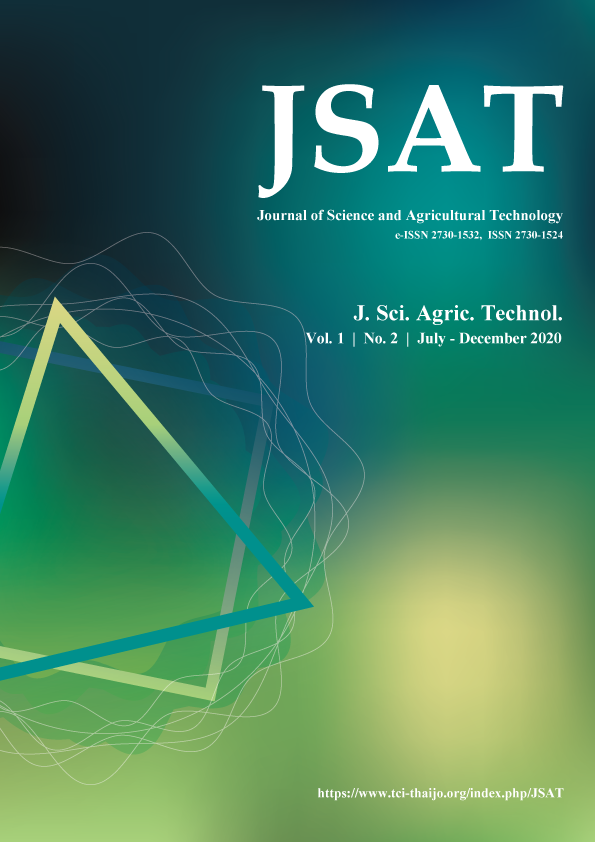The extraction of estrogen-like compounds from Pueraria mirifica, the properties characterization and the preparation of nucleated nanoparticles
Main Article Content
Abstract
Pueraria mirifica (PM), also known as Kwao Krua Khaw, has been used as herbal plant many decades in the Northern of Thailand. The root of PM contains estrogen-like compounds which are less soluble in water resulted in low bioavailability in aquatic animal application. To increase solubility of the compounds, six different polarity solvents were employed for extraction step such as hexane, benzene ethyl acetate, acetone, ethanol, deionized water sequentially. It was found that deionized water exhibited the highest extraction yield percentage. However, the high phenolic compounds and flavonoid yield were obtained in ethyl acetate fraction (EAF). In addition, the results of scavenging radical assay using DPPH IC50 also indicated EAF possesses the highest activity which positively related to the high content of total phenolic content and flavonoid content. Moreover, EAF also exhibited highest proliferation activity against MCF-7, significantly. From findings, EAF was selected for developing polymeric micelles. The HPBCD, Pluronic F-68, and Pluronic F-127 were employed with Tween 80 to fabricate nanoparticles. It was found that the proper ratio of PM-loaded Pluronic F-127 (PM-F127) product, was in nanosize range and elicited zeta potential value of nearly zero mV, exhibited the transparent aqueous dispersions in DI water. It was promising for further use in vivo studies.
Article Details

This work is licensed under a Creative Commons Attribution-NonCommercial-NoDerivatives 4.0 International License.
References
Cherdshewasart, W., Traisup, V., and Picha, P. 2008. Determination of the estrogenic activity of wild phytoestrogen-rich Pueraria mirifica by MCF-7 proliferation assay. Journal of Reproduction and Development. 54(1): 63-67.
Innocenti, G., Vegeto, E., Dall'Acqua, S., Ciana, P., Giorgetti, M., Agradi, E., Sozzi, A., Fico, G., and Tome, F. 2007. In vitro estrogenic activity of Achillea millefolium L. Phytomedicine. 14: 147–52.
Intharuksa, A., Kitamura, M., Peeraklam, N., Charoensup, W., Ando, H., Sasaki, Y., and Sirisa-ard, P. 2020. Evaluation of white Kwao Krua (Pueraria candollei Grah. ex Benth) products sold in Thailand by molecular, chemical, and microscopic analyses. Journal of Natural Medicines. 74: 106-118.
Jeon, G-C., Park, M-S., Yoon, D-Y., Shin, C-H., Sin, H-S., and Um, S-J., 2005. Antitumor activity of spinasterol isolated from Pueraria roots. Experimental and Molecular Medicine. 37(2):.111-120.
Kaurinovic, B. and Vastag, D. 2019. Flavonoids and phenolic acids as potential natural antioxidants. In: Shalaby, E. (ed). Antioxidants. IntechOpen press. The Republic of Serbia. p.1-20.
Lee, J.H., Kim, J.Y., Cho, S-H., Jeong, J.H., Cho, S., Park, H.J., and Baek, S.Y. 2017. Determination of Miroestrol and Isomiroestrol from Pueraria mirifica (White Kwao Krua) in Dietary Supplements by LC–MS-MS and LC–Q-Orbitrap/MS. Journal of Chromatographic Science. 55(3): 214-221.
Lin, T-C., Wang, K-H., Kao, A-P., Chuang, K-H., and Kuo, T-C. 2017. Pueraria mirifica inhibits 17β-estradiol-induced cell proliferation of human endometrial mesenchymal stem cells. Taiwanese Journal of Obstetrics and Gynecology. 56(6):765-769.
Malaivijitnond, S. 2012. Medical applications of phytoestrogens from Pueraria mirifica Thai herb. Frontiers of Medicine. 6(1):8-21.
Mikolajczyk, A., Gajewicz, A., Rasulev, B., Schaeublin, N., Maurer-Gardner, E., Hussain, S., Leszczynski, J., and Puzynet, T. 2015. Zeta potential for metal oxide nanoparticles: a predictive model developed by a nano-quantitative structure-property relationship approach. Chemistry of Materials. 27: 2400-2407.
Peerakam, N., Sirisa-ard, P., Quoc Huy, N., Van On, T., Tuan Long, P., and Intharuksa, A. 2018. Isoflavonoids and phytoestrogens from Pueraria candollei var. mirifica related with appropriate ratios of ethanol extraction. Asian Journal of Chemistry. 30(9): 2086-2090.
Sassa-deepaeng T., Chaisri, W., Pikulkaew, S., and Okonogi, S. 2017. Investigation of antiaromatase activity using hepatic microsomes of Nile tilapia (Oreochromis niloticus). Drug Discoveries & Therapeutics. 11(2): 84-90.
Sassa-deepaeng, T., Pikulkaew, S., and Okonogi, S. 2016. Development of chrysin loaded poloxamer micelles and toxicity evaluation in fish embryos. Drug Discoveries & Therapeutics. 10(3): 150-155.
Sassa-deepaeng, T., Yodthong, W., and Khamphira, T. 2019. Green synthesized copper nanoparticles and their anti-bacterial properties against bullfrog multidrug resistant gram negative bacteria. Veterinary Integrative Sciences. 17(1): 33-49.
Sirisa-ard, P., Peerakam, N., Huy, N.Q., On, T.V., Long, P.T., and Intharuksa, A. 2018. Development of anti-wrinkle cream from Pueraria candollei var. mirifica(airy shaw and suvat.) niyomdham, “kwaokruakao” for menopausal women. International Journal of Pharmacy and Pharmaceutical Sciences. 10(7): 16-21.
Suthon, S., Jaroenporn, S., Charoenphandhu, N., Suntornsaratoon, P., and Malaivijitnond, S. 2016. Anti-osteoporotic effects of Pueraria candollei var. mirifica on bone mineral density and histomorphometry in estrogen-deficient rats. Journal of Natural Medicines. 70: 225-233.
Urasopon, N., Hamada, Y., Asaoka, K., Cherdshewasart, W., Malaivijitnond, S. 2007. Pueraria mirifica, a phytoestrogen-rich herb, prevents bone loss in orchidectomized rats. Maturitas. 56:322-331.
Urasopon, N., Hamada, Y., Cherdshewasart, W., Malaivijitnond, S. 2008. Preventive effects of Pueraria mirifica on bone loss in ovariectomized rats. Maturitas. 59:137–148.
Wanda, G.J.M.K., Njamen, D., Yankep, E., Tagatsing, F. M., Tanee, F. Z., Wober, J., Starcke, S., Zierau, O., and Vollmer, G. 2006. Estrogenic properties of isoflavones derived from Millettia griffoniana. Phytomedicine. 13(3): 139-145.
Yodthong, W., Chaiwongsar, S., Wanachantararak, P., Keereeta, Y., Panthuwat, W., Saovapha, B., and Sassa-deepaeng, T. 2020. Influence of different extraction solvents on antioxidant and antityrosinase activities of Morus alba Linn. leaf extract. Journal of Science and Agricultural Technology. 1(1): 7-17.


